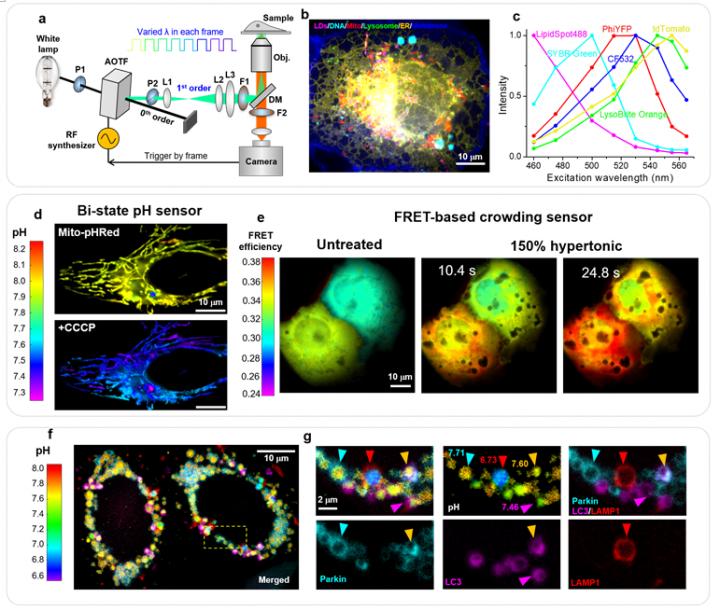
Credit: by Kun Chen, Rui Yan, Limin Xiang, and Ke Xu
The multiplexing capability of fluorescence microscopy is severely limited by the broad fluorescence spectral width. Spectral imaging offers potential solutions, yet typical approaches to disperse the local emission spectra notably impede the attainable throughput and place substantial constraints on temporal resolution. Tunable bandpass filters provide a possibility to scan through the emission wavelength in the wide field. However, applying narrow bandpasses to the fluorescence emission results in inefficient use of the scarce signal.
In a new paper published in Light: Science & Application, a team of scientists, led by Professor Ke Xu from College of Chemistry, University of California, Berkeley, USA have demonstrated that using a single, fixed fluorescence emission detection band, through frame-synchronized fast scanning of the excitation wavelength from a white lamp via an acousto-optic tunable filter (AOTF), up to 6 subcellular targets, labeled by common fluorophores of substantial spectral overlap, can be simultaneously imaged in live cells with low (~1%) crosstalks and high temporal resolutions (down to ~10 ms). The demonstrated capability to quantify the abundances of different fluorophores in the same sample through unmixing the excitation spectra next enabled them to devise novel, quantitative imaging schemes for both bi-state and FRET (Förster resonance energy transfer) fluorescent biosensors in live cells. They thus achieved full-frame high sensitivities and spatiotemporal resolutions in quantifying the mitochondrial matrix pH and the intracellular macromolecular crowding. They thus unveiled significant spatial heterogeneities in both parameters, including spontaneous sudden jumps in the mitochondrial matrix pH accompanied by dramatic mitochondrial shape changes. They further demonstrated, for the first time, the multiplexing of absolute pH imaging with three additional target organelles/proteins to elucidate the complex, Parkin-mediated mitophagy pathway.
“The potential extension of our approach to even more fluorophores may be achieved by further increasing the number of excitation wavelengths or integrating emission dispersion” “Whereas in this work we focused on a facile system based on a lamp-operated epifluorescence microscope, the fast multi-fluorophore and quantitative biosensor imaging capabilities we demonstrated here should be readily extendable to other systems, including light-sheet fluorescence microscopy and structured illumination microscopy” the scientists discussed.
Together, these results “unveil the exceptional opportunities excitation spectral microscopy provides for highly multiplexed fluorescence imaging.” “The prospect of acquiring fast spectral images in the wide-field without the need for fluorescence dispersion or the care for the spectral response of the detector offers tremendous potential.”
###
Media Contact
Ke Xu
[email protected]
Related Journal Article
http://dx.




